Numerical Simulation Study on the Evolution Law of Stress and Crack in Coal Seam Hydraulic Fracturing
Abstract
1. Introduction
2. The Establishment of a Finite-Discrete Element Model of Hydraulic Fracturing
3. Validation of Finite-Discrete Element Model of Hydraulic Fracturing
3.1. Parameters Selection of Numerical Model
3.2. Comparative Analysis of Simulation Results
4. Application of Finite-Discrete Element Model of Hydraulic Fracturing
4.1. Experimental Protocol
4.2. Analysis of the Evolution Law of Stress and Crack with Time in Hydraulic Fracturing
4.3. Analysis of the Evolution Law of Stress and Crack in Hydraulic Fracturing under Different Elastic Modulus
4.4. Analysis of the Evolution Law of Stress and Crack in Hydraulic Fracturing under Different Permeability
5. Conclusions
Author Contributions
Funding
Institutional Review Board Statement
Informed Consent Statement
Data Availability Statement
Acknowledgments
Conflicts of Interest
References
- Jia, A.; Cheng, G.; Chen, W.; Li, Y. Forecast of natural gas supply and demand in China under the background of ?Dual Carbon Targets? Pet. Explor. Dev. 2023, 50, 492–504. [Google Scholar] [CrossRef]
- Tao, S.; Chen, S.D.; Pan, Z.J. Current status, challenges, and policy suggestions for coalbed methane industry development in China: A review. Energy Sci. Eng. 2019, 7, 1059–1074. [Google Scholar] [CrossRef]
- Wei, J.; Niu, C.-H. How does institutional support affect the coalbed methane industry? Front. Energy Res. 2023, 10, 1087984. [Google Scholar] [CrossRef]
- Li, R.; Li, G. Coalbed Methane Industry Development Framework and Its Limiting Factors in China. Geofluids 2022, 2022, 8336315. [Google Scholar] [CrossRef]
- Peng, T.; Chen, Y.; Wang, L.; Ma, D.; Li, G.; Li, W.; Zheng, C.; Ji, Y.; Ma, Z.; Hui, P.; et al. Mechanism of Methane Adsorption/Desorption in Low-Rank Vitrain and Durain Coal Affected by Pore Structure and Wettability: A Case Study in Dafosi Area, South Ordos Basin, China. Energies 2022, 15, 5094. [Google Scholar] [CrossRef]
- Zhao, D.; Guo, Y.; Wang, G.; Guan, X.; Zhou, X.; Liu, J. Fractal Analysis and Classification of Pore Structures of High-Rank Coal in Qinshui Basin, China. Energies 2022, 15, 6766. [Google Scholar] [CrossRef]
- Li, F.; Liu, H.W.; Wang, C.C.; Sun, R.C.; Xiang, G.Y.; Ren, B.R.; Wang, G.H. Stress Relief and Permeability Enhancement with Hydraulic Fracturing in Overlying Key Strata of Deep and Soft Coal Seams. ACS Omega 2023, 8, 12183–12193. [Google Scholar] [CrossRef]
- Zhang, C.; Wang, E.; Xu, J.; Peng, S. A new method for coal and gas outburst prediction and prevention based on the fragmentation of ejected coal. Fuel 2021, 287, 119493. [Google Scholar] [CrossRef]
- Zhang, Y.; Li, Q.; Hu, Q.; Zhai, C.; Song, M.; Xu, J.; Deng, Y.; Liu, P.; Sun, Y.; Shi, J.; et al. Pore wetting process characterization of Equal-Sized granular coals by using LF-NMR technology. Fuel 2022, 313, 122670. [Google Scholar] [CrossRef]
- Chang, Y.; Yao, Y.; Liu, D.; Liu, Y.; Cui, C.; Wu, H. Behavior and mechanism of water imbibition and its influence on gas permeability during hydro-fracturing of a coalbed methane reservoir. J. Pet. Sci. Eng. 2022, 208, 109745. [Google Scholar] [CrossRef]
- Li, P.; Wang, J.; Liang, W.; Sun, R. An Analytical and Numerical Analysis for Hydraulic Fracture Propagation through Reservoir Interface in Coal-Measure Superimposed Reservoirs. Sustainability 2023, 15, 4597. [Google Scholar] [CrossRef]
- Liu, H.; Li, X.; Yu, Z.; Tan, Y.; Ding, Y.; Chen, D.; Wang, T. Influence of hole diameter on mechanical properties and stability of granite rock surrounding tunnels. Phys. Fluids 2023, 35, 064121. [Google Scholar] [CrossRef]
- Zheng, C.S.; Jiang, B.Y.; Xue, S.; Chen, Z.W.; Li, H. Coalbed methane emissions and drainage methods in underground mining for mining safety and environmental benefits: A review. Process Saf. Environ. Prot. 2019, 127, 103–124. [Google Scholar] [CrossRef]
- Liang, W.; Yang, J.; Lian, H.; Wang, Z.; Shen, W. Modelling ductile failure of coals in hydraulic fracturing based on the constitutive equations of cohesive cracks. J. China Coal Soc. 2019, 44, 263–270. [Google Scholar] [CrossRef]
- Huang, L.; Li, B.; Wang, B.; Zhang, J. Effects of coal bedding dip angle on hydraulic fracturing crack propagation. Geomech. Geophys. Geo-Energy Geo-Resour. 2023, 9, 30. [Google Scholar] [CrossRef]
- Jia, J.; Wang, D.; Li, B. Study on influencing factors of effective fracturing radius of hydraulic fracturing. J. Saf. Sci. Technol 2022, 18, 58–64. [Google Scholar] [CrossRef]
- Lu, Y.; Huang, S.; Ge, Z.; Zhou, Z.; Song, Z. Fluid-driven cracking behavior of coal with prefabricated plane: A particle-based hydro-mechanical coupled numerical investigation. Theor. Appl. Fract. Mech. 2023, 124, 103825. [Google Scholar] [CrossRef]
- Ma, Y.; Wang, D.; Zheng, Y. Influence of the bedding plane on the propagation of multiple hydraulic fractures. Front. Earth Sci. 2023, 10, 1077652. [Google Scholar] [CrossRef]
- Li, Y.; Liu, J.; Yu, Q. Patterns of Influence of Parallel Rock Fractures on the Mechanical Properties of the Rock–Coal Combined Body. Sustainability 2022, 14, 13555. [Google Scholar] [CrossRef]
- Fu, S.; Hou, B.; Xia, Y.; Chen, M.; Wang, S.; Tan, P. The study of hydraulic fracture height growth in coal measure shale strata with complex geologic characteristics. J. Pet. Sci. Eng. 2022, 211, 110164. [Google Scholar] [CrossRef]
- Jia, Q.; Liu, D.; Cai, Y.; Fang, X.; Li, L. Petrophysics characteristics of coalbed methane reservoir: A comprehensive review. Front. Earth Sci. 2021, 15, 202–223. [Google Scholar] [CrossRef]
- Li, S.; Tang, D.; Pan, Z.; Xu, H.; Tao, S.; Liu, Y.; Ren, P. Geological conditions of deep coalbed methane in the eastern margin of the Ordos Basin, China: Implications for coalbed methane development. J. Nat. Gas Sci. Eng. 2018, 53, 394–402. [Google Scholar] [CrossRef]
- Liu, D.; Jia, Q.; Cai, Y.; Gao, C.; Qiu, F.; Zhao, Z.; Chen, S. A new insight into coalbed methane occurrence and accumulation in the Qinshui Basin, China. Gondwana Res. 2022, 111, 280–297. [Google Scholar] [CrossRef]
- Liu, S.M.; Sun, H.T.; Zhang, D.M.; Yang, K.; Li, X.L.; Wang, D.K.; Li, Y.N. Experimental study of effect of liquid nitrogen cold soaking on coal pore structure and fractal characteristics. Energy 2023, 275, 127470. [Google Scholar] [CrossRef]
- Liu, H. Wing-crack initiation angle: A new maximum tangential stress criterion by considering T-stress. Eng. Fract. Mech. 2018, 199, 380–391. [Google Scholar] [CrossRef]
- Wang, Z.; Zhang, Q.; Zhang, W. A novel collaborative study of abnormal roof water inrush in coal seam mining based on strata separation and wing crack initiation. Eng. Fail. Anal. 2022, 142, 106762. [Google Scholar] [CrossRef]
- Lisjak, A.; Kaifosh, P.; He, L.; Tatone, B.S.A.; Mahabadi, O.K.; Grasselli, G. A 2D, fully-coupled, hydro-mechanical, FDEM formulation for modelling fracturing processes in discontinuous, porous rock masses. Comput. Geotech. 2017, 81, 1–18. [Google Scholar] [CrossRef]
- Yan, C.Z.; Guo, H.; Tang, Z.C. Three-dimensional continuous-discrete pore-fracture mixed seepage model and hydro-mechanical coupling model to simulate hydraulic fracturing. J. Pet. Sci. Eng. 2022, 215, 110510. [Google Scholar] [CrossRef]
- Yan, C.Z.; Xie, X.; Ren, Y.H.; Ke, W.H.; Wang, G. A FDEM-based 2D coupled thermal-hydro-mechanical model for multiphysical simulation of rock fracturing. Int. J. Rock Mech. Min. Sci. 2022, 149, 104964. [Google Scholar] [CrossRef]
- Wang, X.; Wang, E.; Liu, X.; Li, N.; Zhou, X. Three-point-bending test of crack propagation and fracture parameters of coal specimens. Chin. J. Rock Mech. Eng 2021, 40, 690–702. [Google Scholar] [CrossRef]
- Wang, S.; Tan, F.; Lv, J.; You, M. Discrete element numerical simulation of hydraulic fracturing based on Hoek-Brown strength criterion. Eng. J. Wuhan Univ. 2021, 54, 290–297. [Google Scholar] [CrossRef]
- Yan, C.; Zheng, H.; Sun, G.; Ge, X. Effect of in-situ stress on hydraulic fracturing based on FDEM-Flow. Rock Soil Mech. 2016, 37, 237–246. [Google Scholar] [CrossRef]
- Liu, C.; Li, S.G.; Qin, S.; Yang, S.G. Research and Application of Influences of Lateral Pressure Coefficients on the Extension Angle of Coal Cracks. Math. Probl. Eng. 2016, 2016, 3068347. [Google Scholar] [CrossRef]
- Wang, H.; Gong, W.; Yuan, G.; Wang, X.; Zhao, J.; Su, Y.; Wang, Y. Effect of In-Situ Stress on Hydraulic Fracturing of Tight Sandstone Based on Discrete Element Method. Energies 2022, 15, 5620. [Google Scholar] [CrossRef]
- Zhang, X.; Si, G.; Bai, Q.; Xiang, Z.; Li, X.; Oh, J.; Zhang, Z. Numerical simulation of hydraulic fracturing and associated seismicity in lab-scale coal samples: A new insight into the stress and aperture evolution. Comput. Geotech. 2023, 160, 105507. [Google Scholar] [CrossRef]
- Feng, Z.; Yang, Y.; Niu, W.; Zhao, Y.; Wan, Z.; Yao, Y. Permeability and meso-structure evolution of coking coal subjected to long-term exposure of triaxial stresses and high-pressure nitrogen. Geomech. Geophys. Geo-Energy Geo-Resour. 2020, 6, 41. [Google Scholar] [CrossRef]
- Shao, P.; Wang, X.; Song, Y.; Li, Y. Study on the characteristics of matrix compressibility and its influence factors for different rank coals*. J. Nat. Gas Sci. Eng. 2018, 56, 93–106. [Google Scholar] [CrossRef]
- Tang, S.; Tang, D.; Xu, H.; Tao, S.; Li, S.; Geng, Y. Geological mechanisms of the accumulation of coalbed methane induced by hydrothermal fluids in the western Guizhou and eastern Yunnan regions. J. Nat. Gas Sci. Eng. 2016, 33, 644–656. [Google Scholar] [CrossRef]
- Li, X.; Zhang, X.; Shen, W.; Zeng, Q.; Chen, P.; Qin, Q.; Li, Z. Research on the Mechanism and Control Technology of Coal Wall Sloughing in the Ultra-Large Mining Height Working Face. Int. J. Environ. Res. Public Health 2023, 20, 868. [Google Scholar] [CrossRef]
- Llanos, E.M.; Jeffrey, R.G.; Hillis, R.; Zhang, X. Hydraulic fracture propagation through an orthogonal discontinuity: A laboratory, analytical and numerical study. Rock Mech. Rock Eng. 2017, 50, 2101–2118. [Google Scholar] [CrossRef]
- Zhang, J.; Li, X.; Qin, Q.; Wang, Y.; Gao, X. Study on overlying strata movement patterns and mechanisms in super-large mining height stopes. Bull. Eng. Geol. Environ. 2023, 82, 142. [Google Scholar] [CrossRef]
- Zhang, L.; Shen, W.; Li, X.; Wang, Y.; Qin, Q.; Lu, X.; Xue, T. Abutment Pressure Distribution Law and Support Analysis of Super Large Mining Height Face. Int. J. Environ. Res. Public Health 2023, 20, 227. [Google Scholar] [CrossRef] [PubMed]
- Yang, Z.; Li, Y.; Qin, Y.; Sun, H.; Zhang, P.; Zhang, Z.; Wu, C.; Li, C.; Chen, C. Development unit division and favorable area evaluation for joint mining coalbed methane. Pet. Explor. Dev. Online 2019, 46, 583–593. [Google Scholar] [CrossRef]
- Liu, S.; Wang, D.; Yin, G.; Li, M.; Li, X. Experimental study on the microstructure evolution laws in coal seam affected by temperature impact. Rock Mech. Rock Eng. 2020, 53, 1359–1374. [Google Scholar] [CrossRef]
- Zhang, L.; Huang, M.; Xue, J.; Li, M.; Li, J. Repetitive mining stress and pore pressure effects on permeability and pore pressure sensitivity of bituminous coal. Nat. Resour. Res. 2021, 30, 4457–4476. [Google Scholar] [CrossRef]
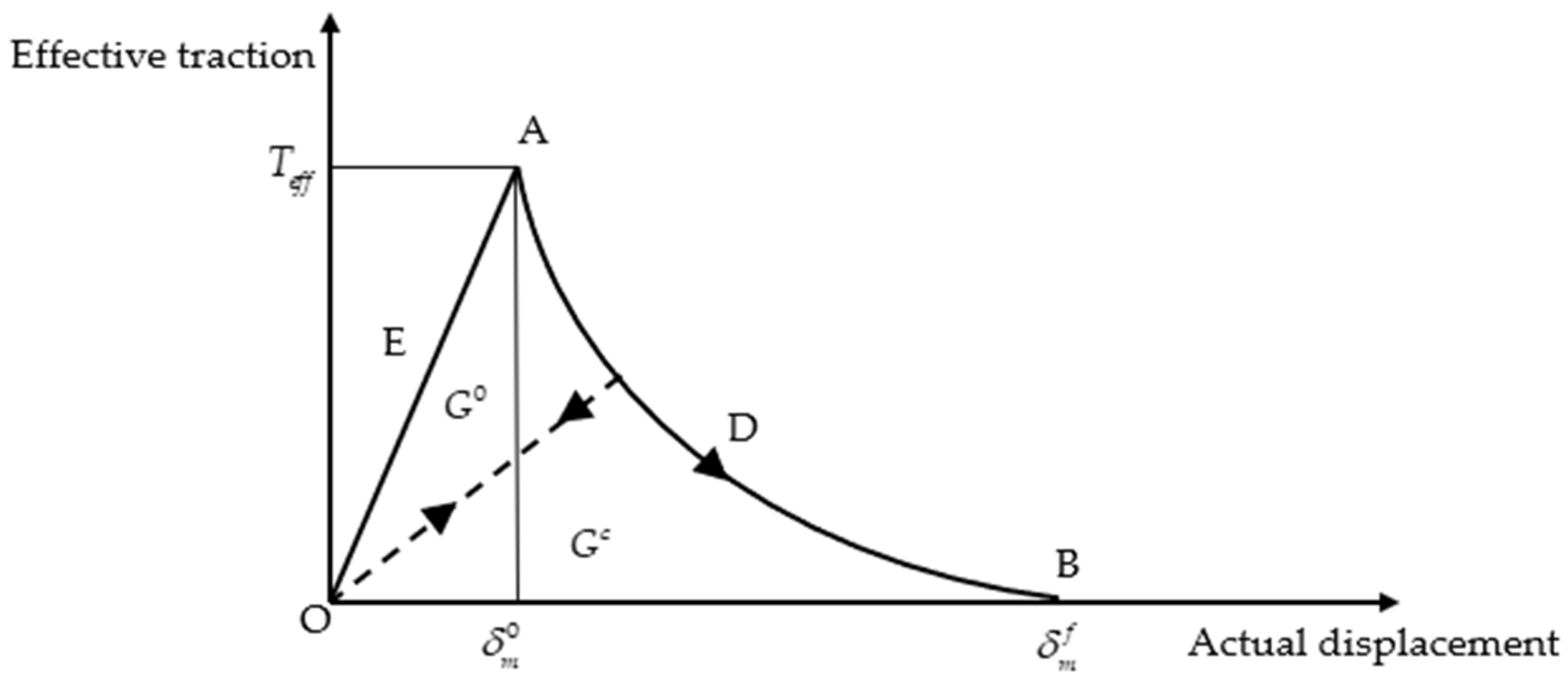
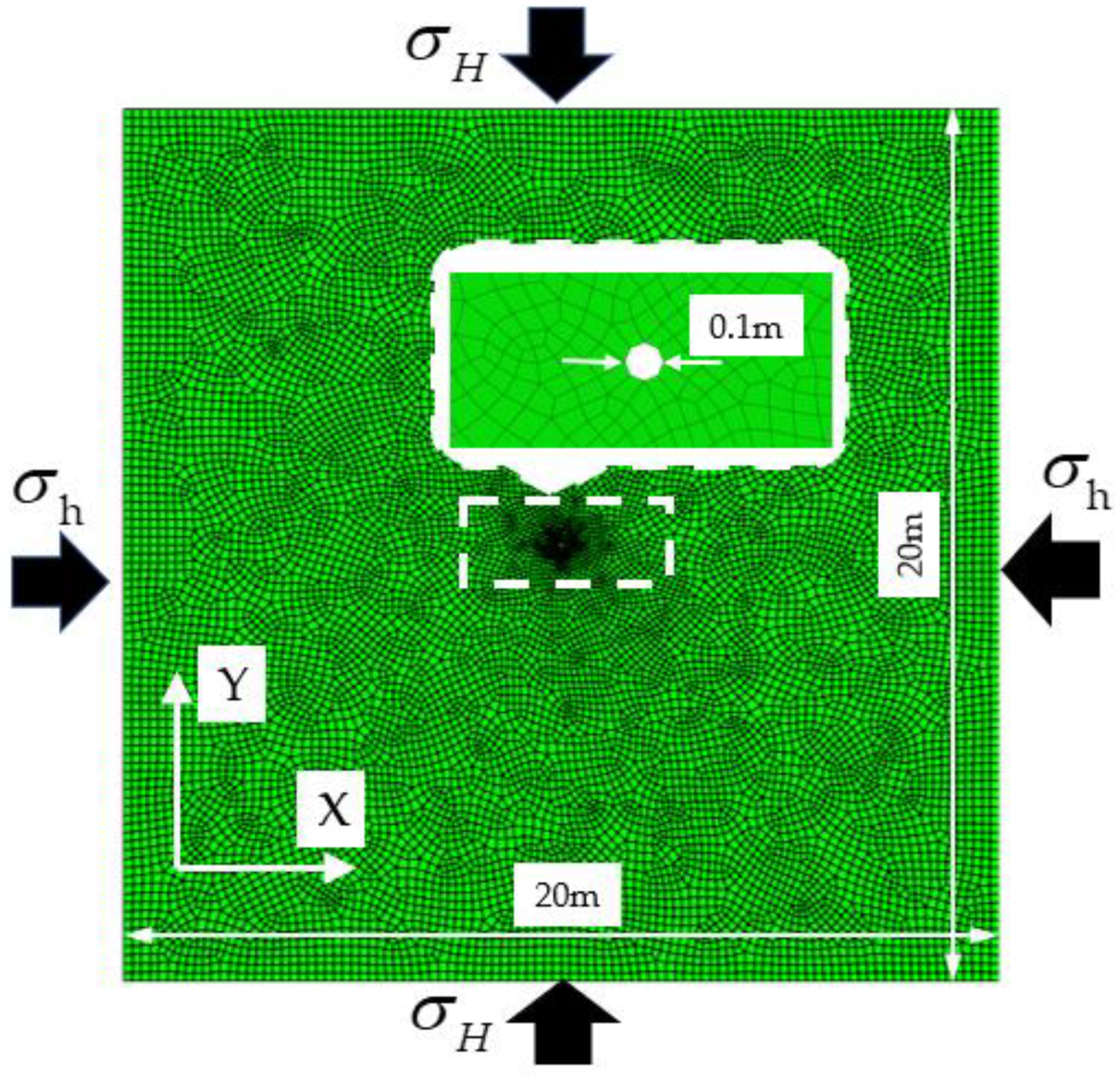
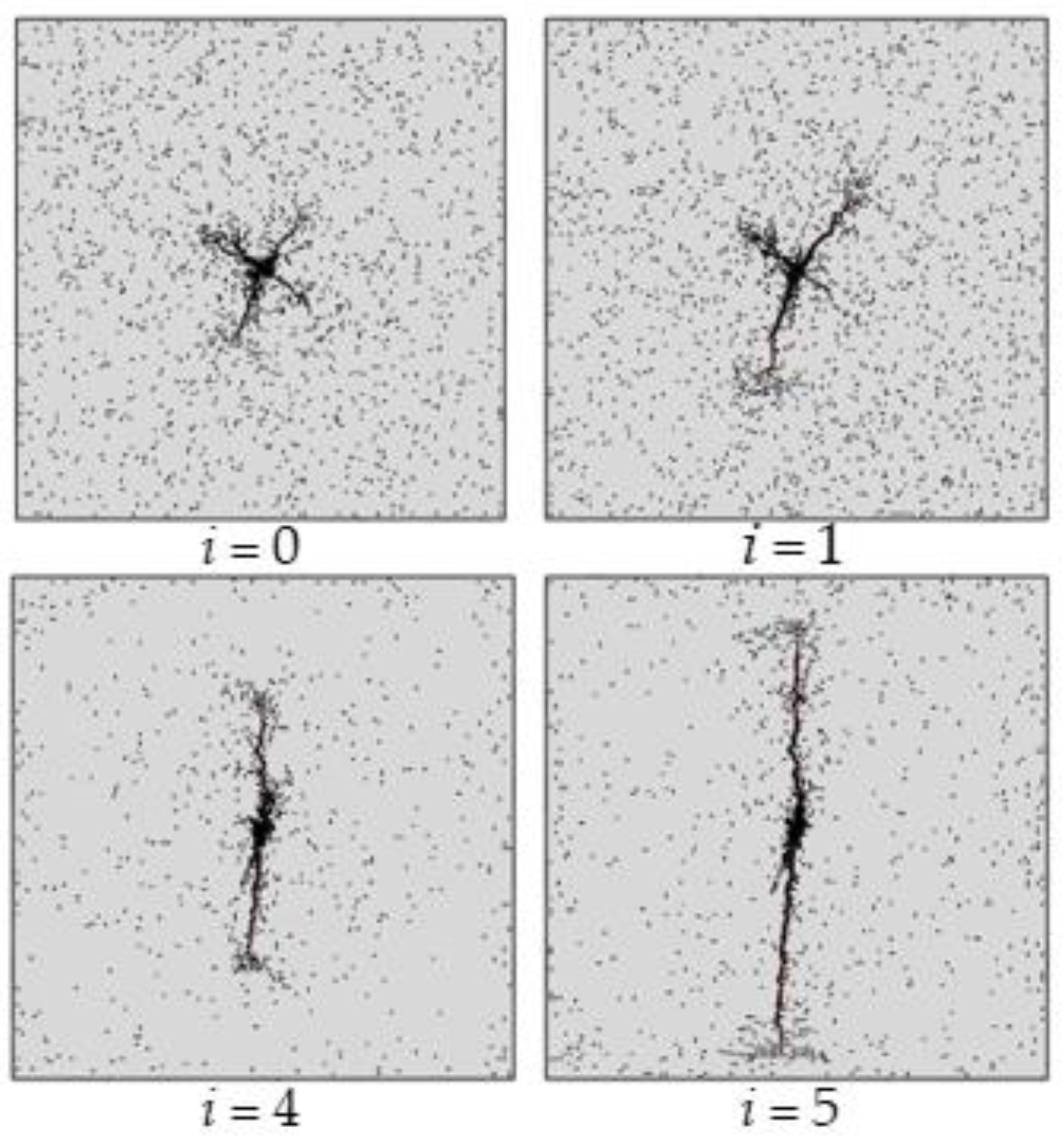
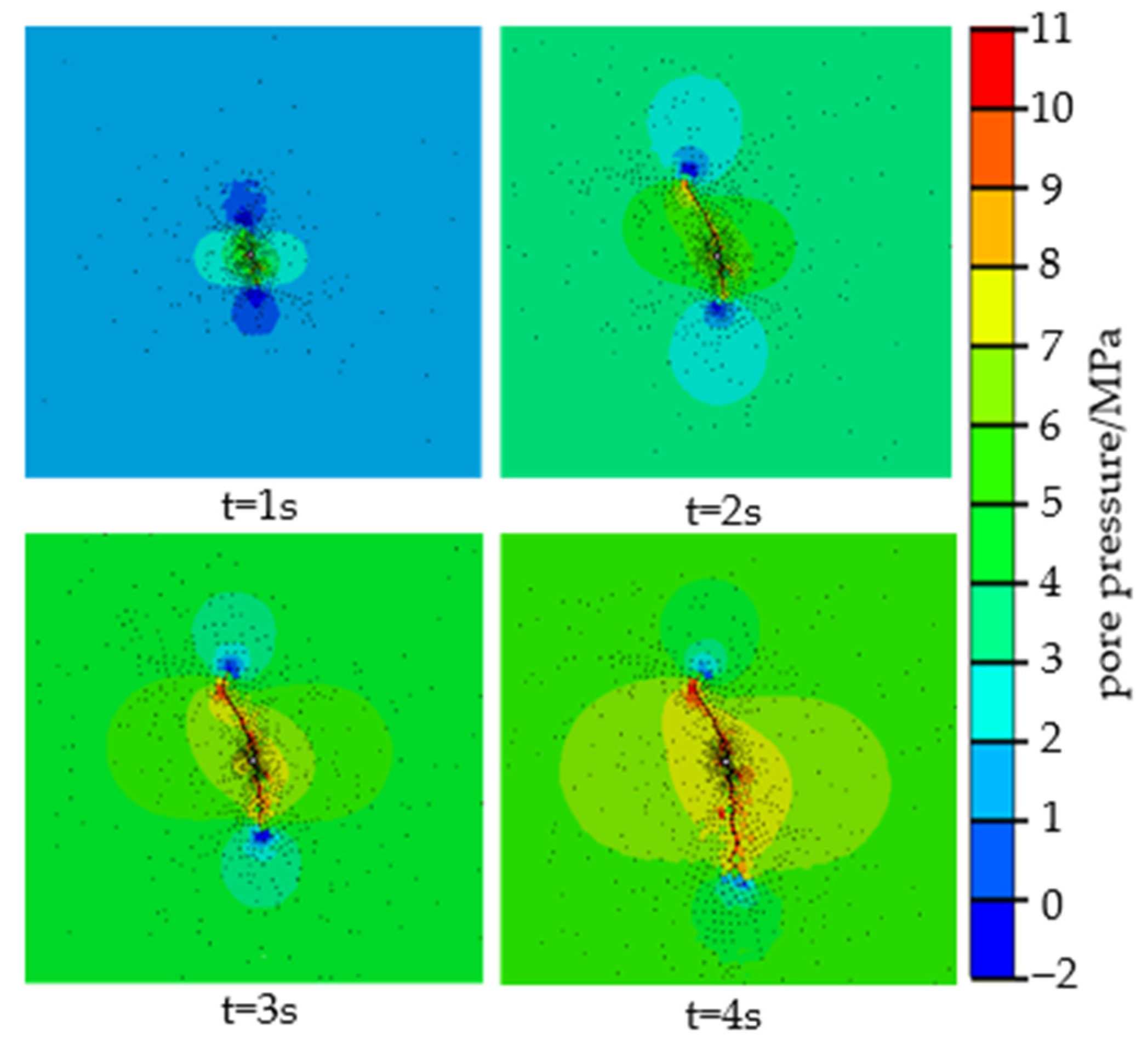
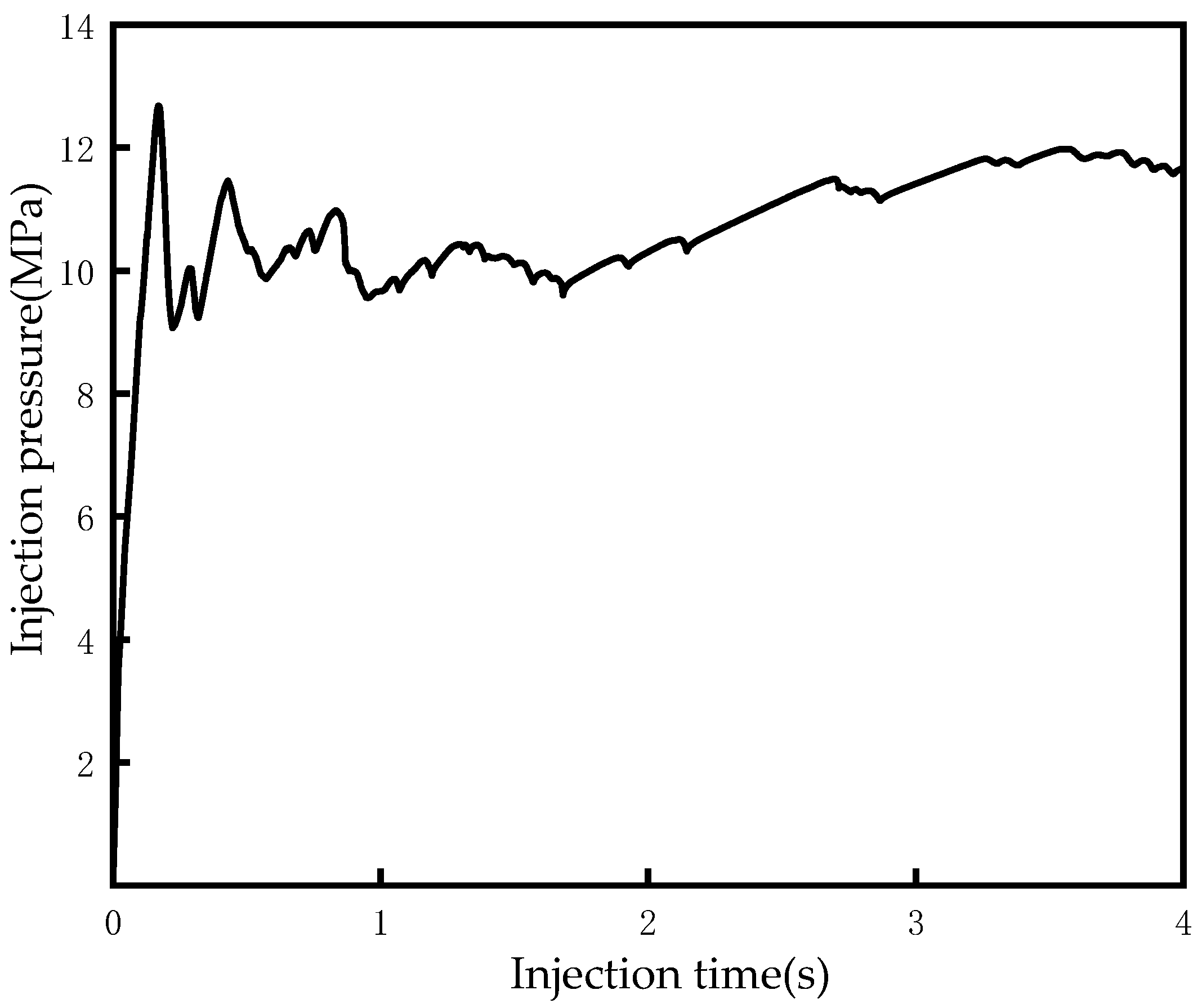
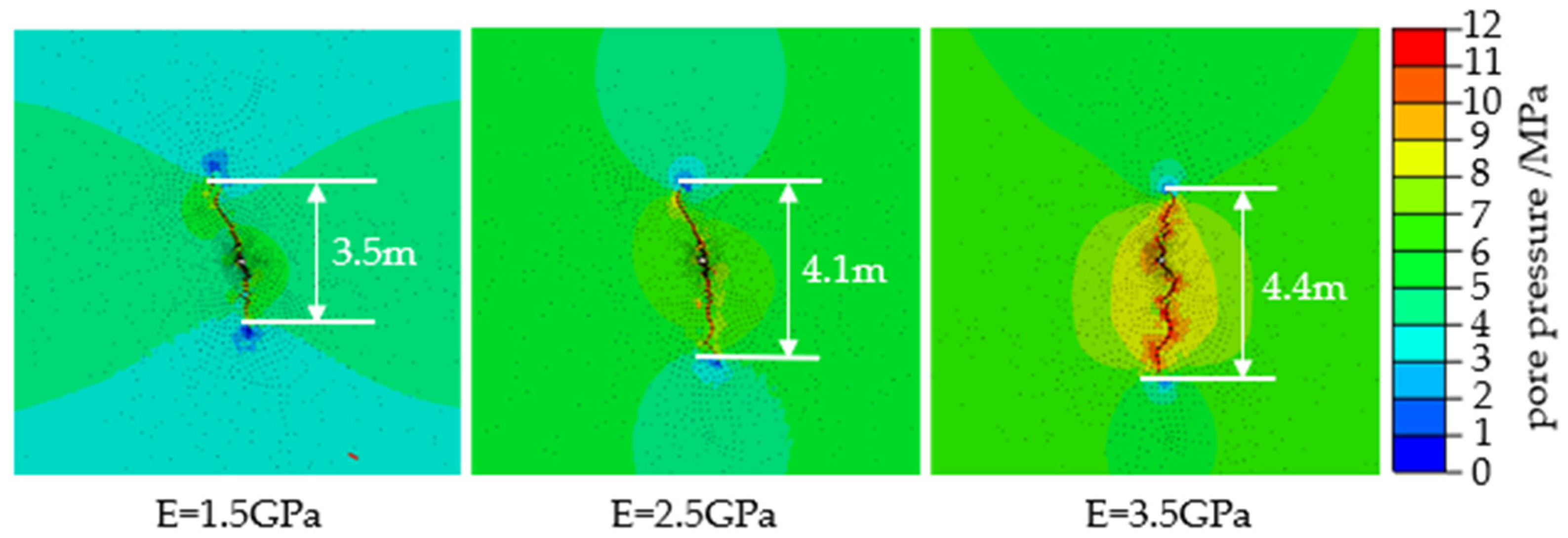

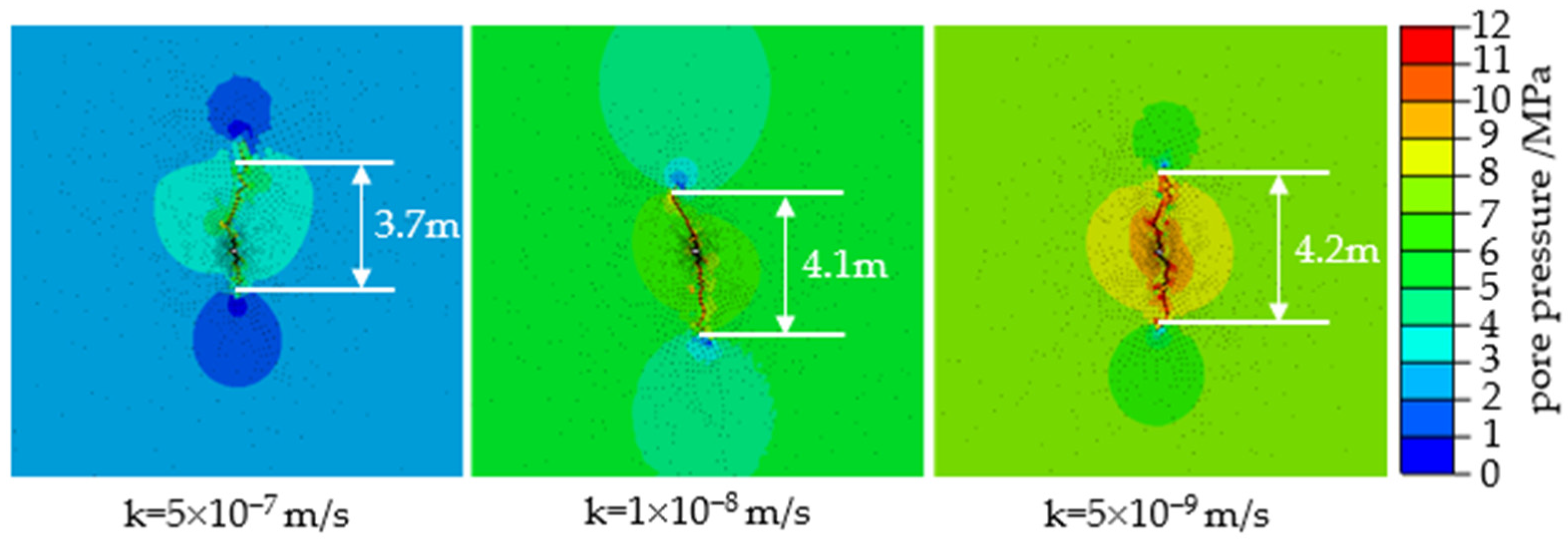
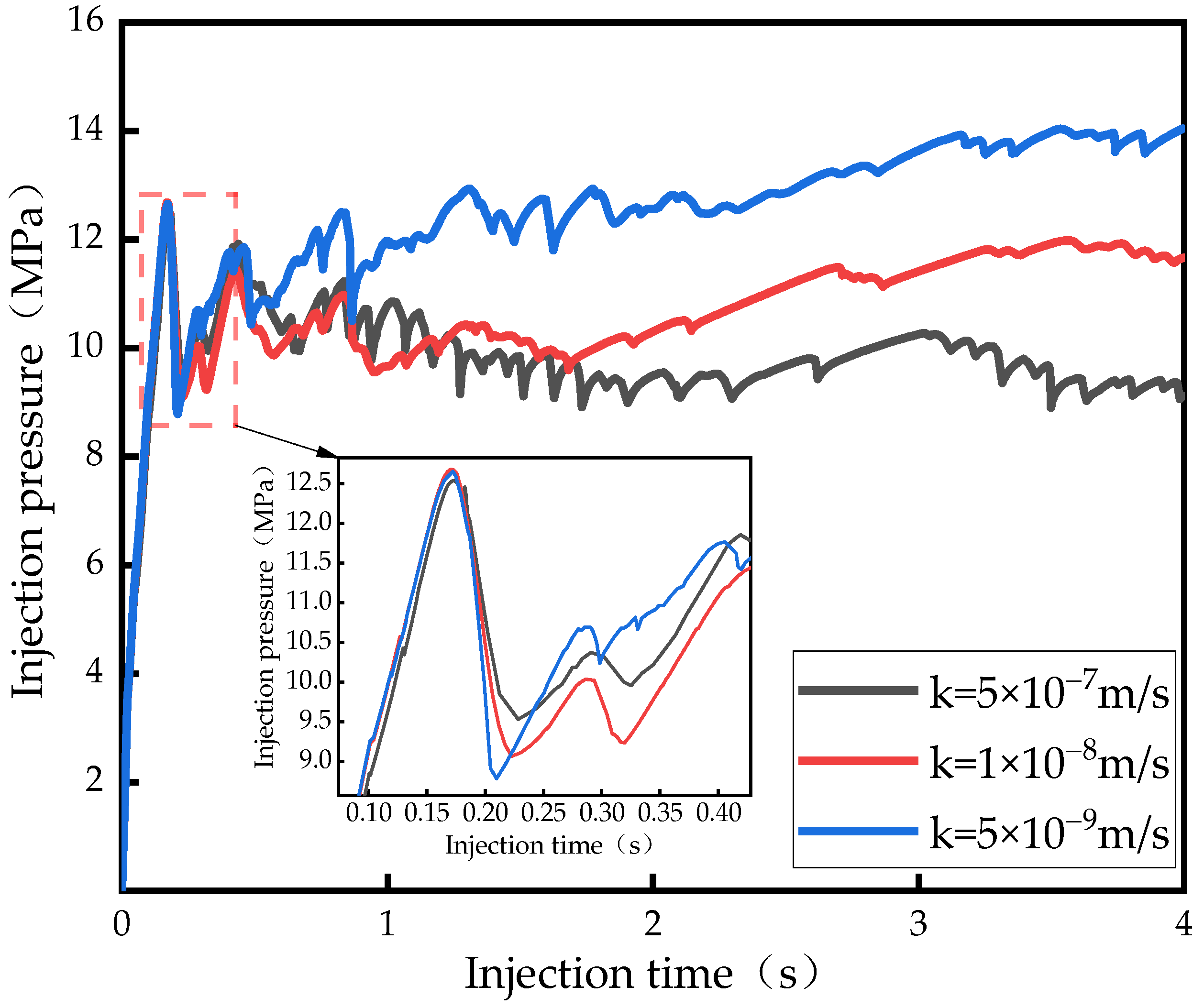
| Models | Parameters | Takes Values |
|---|---|---|
| Entity unit | Elasticity modulus (GPa) | 2.5 |
| Poisson ratio | 0.32 | |
| Permeability coefficient (m/s) | 10−8 | |
| Porosity | 0.1 | |
| Cohesive element | I type fracture energy (N/m) | 49.58 |
| II type fracture energy (N/m) | 194.3 | |
| Normal stiffness (GPa) | 2.5 | |
| Tangential stiffness (GPa) | 2.5 | |
| (B-K) Guidelines | 2.54 | |
| Fluids | Viscosity (Pa s) | 0.001 |
| Density (kg/m3) | 1000 | |
| Injection flow rate (m3/s) | 0.003 |
| Number | (MPa) | (MPa) | (MPa) | Simulation Results (MPa) | HB Criterion Results (MPa) | Error (%) |
|---|---|---|---|---|---|---|
| 1 | 5 | 5 | 0 | 14.89 | 14.94 | 0.33 |
| 2 | 6 | 5 | 1 | 14.15 | 14.18 | 0.21 |
| 3 | 7 | 5 | 2 | 13.34 | 13.41 | 0.52 |
| 4 | 8 | 5 | 3 | 12.58 | 12.65 | 0.55 |
| 5 | 9 | 5 | 4 | 11.81 | 11.87 | 0.51 |
| 6 | 10 | 5 | 5 | 11.07 | 11.12 | 0.45 |
| Number | Modulus of Elasticity (GPa) | Permeability Coefficient (m/s) | Fracturing Time (s) |
|---|---|---|---|
| 1 | 2.5 | 10−8 | 1 |
| 2 | 2.5 | 10−8 | 2 |
| 3 | 2.5 | 10−8 | 3 |
| 4 | 2.5 | 10−8 | 4 |
| 5 | 1.5 | 10−8 | 4 |
| 6 | 3.5 | 10−8 | 4 |
| 7 | 2.5 | 5 × 10−7 | 4 |
| 8 | 2.5 | 5 × 10−9 | 4 |
Disclaimer/Publisher’s Note: The statements, opinions and data contained in all publications are solely those of the individual author(s) and contributor(s) and not of MDPI and/or the editor(s). MDPI and/or the editor(s) disclaim responsibility for any injury to people or property resulting from any ideas, methods, instructions or products referred to in the content. |
© 2023 by the authors. Licensee MDPI, Basel, Switzerland. This article is an open access article distributed under the terms and conditions of the Creative Commons Attribution (CC BY) license (https://creativecommons.org/licenses/by/4.0/).
Share and Cite
Yang, S.; Xu, N.; Zhang, X. Numerical Simulation Study on the Evolution Law of Stress and Crack in Coal Seam Hydraulic Fracturing. Sustainability 2023, 15, 11351. https://doi.org/10.3390/su151411351
Yang S, Xu N, Zhang X. Numerical Simulation Study on the Evolution Law of Stress and Crack in Coal Seam Hydraulic Fracturing. Sustainability. 2023; 15(14):11351. https://doi.org/10.3390/su151411351
Chicago/Turabian StyleYang, Shouguo, Ning Xu, and Xiaofei Zhang. 2023. "Numerical Simulation Study on the Evolution Law of Stress and Crack in Coal Seam Hydraulic Fracturing" Sustainability 15, no. 14: 11351. https://doi.org/10.3390/su151411351
APA StyleYang, S., Xu, N., & Zhang, X. (2023). Numerical Simulation Study on the Evolution Law of Stress and Crack in Coal Seam Hydraulic Fracturing. Sustainability, 15(14), 11351. https://doi.org/10.3390/su151411351






